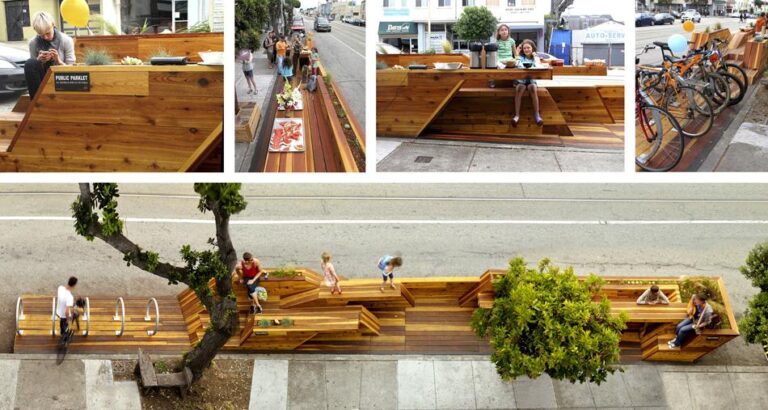The Rise and Fall of San Francisco’s Parklets: A New Chapter in Urban Space Management
For more than ten years, San Francisco’s parklets have been a distinctive feature of the city’s streetscape, transforming ordinary parking spaces into lively outdoor areas for dining, art, and greenery. These small-scale public spaces symbolized the city’s dedication to pedestrian-friendly urban design and community engagement. However, recent shifts in municipal policies, budget constraints, and changing transportation priorities have prompted city officials to reconsider the future of these installations. The San Francisco Chronicle highlights that this marks the conclusion of what many regarded as a groundbreaking yet temporary experiment in reclaiming curbside space.
While parklets contributed positively by boosting pedestrian activity and stimulating local economies, challenges such as upkeep costs, safety compliance, and traffic disruptions have complicated their sustainability. The city’s comprehensive review will focus on:
- Balancing maintenance expenses against available funding
- Assessing effects on vehicular flow and parking capacity
- Incorporating community input and addressing equitable access to public spaces
Stakeholders remain hopeful that innovative urban design solutions will emerge to harmonize public outdoor spaces with San Francisco’s evolving infrastructure needs.
Community Perspectives: Cultural and Economic Consequences of Parklet Removal
Local residents and business owners have expressed deep concern over the dismantling of parklets, emphasizing the significant cultural and economic void left in neighborhoods across the city. Many regard these spaces as vital community anchors that foster social interaction and support small enterprises by drawing consistent pedestrian traffic. The removal has sparked worries about diminishing neighborhood vitality and the erosion of San Francisco’s distinctive street culture.
From an economic standpoint, restaurateurs and shopkeepers report a noticeable downturn in customer visits since the parklets were taken away. Key issues raised in recent public forums and social media conversations include:
- Reduced availability of outdoor seating, particularly critical during peak seasons
- Lower visibility and footfall for small businesses formerly benefiting from parklet adjacency
- Fewer inclusive public spaces that once showcased local art and community events
| Area of Impact | Community Feedback | Economic Effect |
|---|---|---|
| Neighborhood Cohesion | “Loss of vital gathering places for locals” | Weekend foot traffic down by approximately 18% |
| Small Business Revenue | “Sales have declined since parklets were removed” | Estimated 15-20% drop in revenue |
| City’s Cultural Identity | “Parklets embodied San Francisco’s unique street vibe” | Decrease in public art installations and performances |
Rethinking Public Outdoor Spaces: Urban Design Experts Suggest Forward-Thinking Alternatives
As San Francisco phases out its parklet program, urban planners and design professionals stress the necessity of reimagining how public outdoor spaces can be preserved and enhanced in the city’s dense environment. These compact green spaces, often created by repurposing parking spots, provided essential urban relief and social hubs. Yet, concerns over maintenance costs, safety, and traffic interference have driven the decision to retire them. Experts warn that eliminating parklets without introducing effective substitutes could weaken the social connectivity and accessibility that such spaces foster.
Potential alternatives include:
- Seasonal pop-up parks that activate streets during high-use periods
- Modular, multifunctional street furniture designed for easy upkeep and adaptability
- Permanent pedestrian plazas created through traffic calming and road narrowing initiatives
- Enhanced partnerships among community organizations, businesses, and city planners to co-develop public spaces
| Alternative Model | Advantages | Limitations |
|---|---|---|
| Pop-up Parks | Flexible timing and strong community involvement | Temporary nature and weather sensitivity |
| Pedestrian Plazas | Permanent public gathering spaces and reduced traffic | High initial investment and complex planning processes |
| Modular Street Furniture | Versatile use and low maintenance requirements | Limited spatial impact and potential for clutter |
Strategies to Balance Pedestrian Accessibility with Urban Development in San Francisco
To successfully integrate pedestrian needs with the city’s growth trajectory, planners must emphasize walkability in both current and future projects. This includes widening sidewalks, installing dedicated bike lanes, and enhancing crosswalk safety features to preserve San Francisco’s pedestrian-friendly atmosphere amid rising foot traffic. Additionally, temporary pop-up plazas can serve as adaptive public spaces during construction or redevelopment phases, maintaining community engagement throughout urban transformation.
Revising zoning policies to encourage mixed-use developments that blend residential, commercial, and leisure functions can further invigorate street life without compromising pedestrian comfort. The table below outlines key recommendations aimed at achieving these goals:
| Focus Area | Recommended Action | Anticipated Benefit |
|---|---|---|
| Sidewalk Infrastructure | Expand sidewalk widths and incorporate street furniture | Enhanced pedestrian flow and comfort |
| Traffic Control | Deploy pedestrian-priority traffic signals | Improved safety for street crossings |
| Public Space Design | Develop modular parklets with adaptable uses | Preserves outdoor social spaces beyond the parklet era |
| Zoning and Land Use | Promote mixed-use, human-scale developments | Fosters integrated living, working, and leisure environments |
Conclusion: San Francisco’s Next Steps in Public Space Innovation
As San Francisco phases out its once-celebrated parklet initiative, the city faces a pivotal moment in redefining its urban landscape. These small, community-oriented spaces, once praised for enhancing social interaction and outdoor dining, are now being reconsidered amid evolving regulatory frameworks and fiscal realities. This transition highlights broader discussions about optimizing public space usage to balance pedestrian needs, business vitality, and traffic flow in a rapidly changing metropolis. Both residents and policymakers will be closely monitoring how San Francisco innovates to create dynamic, accessible streetscapes that serve all community members in the years ahead.




